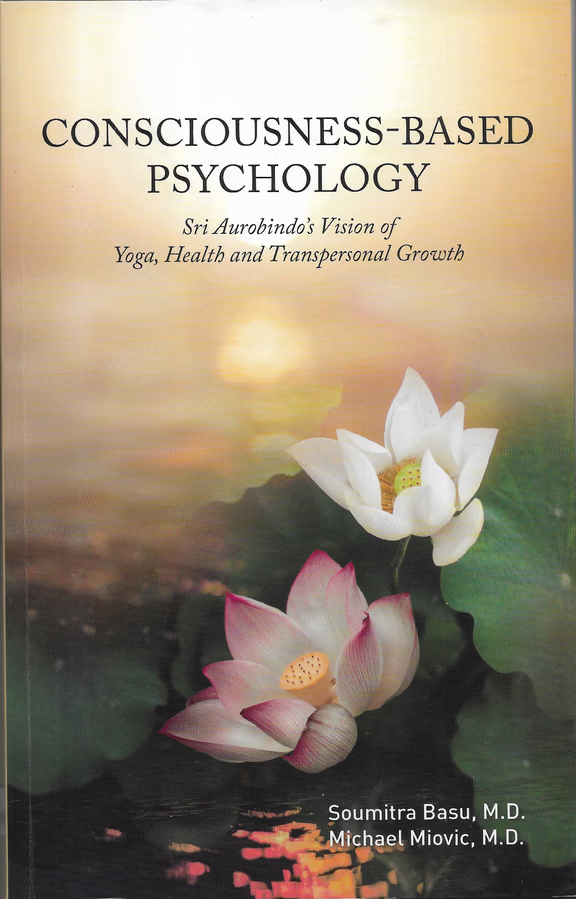Consciousness-Based Psychology
Book reviewBy Carel
Keywords: New publications, Books, Sri Aurobindo’s Integral Psychology, Consciousness, Psychology, Psychiatry, Subconscient, Dreams and Evolution

Consciousness-Based Psychology
Co-authored by Indian psychiatrist Dr Soumitra Basu and American psychiatrist Dr Michael Miovic — both long-time students of Sri Aurobindo’s teachings — the book introduces what the authors call “Consciousness-Based Psychology” (CBP). As Sri Aurobindo never wrote a formal work on psychology, the authors delved into his extensive writings to find his comments on psychology. The words of The Mother, as recorded in her Entretiens and Agenda, have served as another important source.
The authors explain, “In this book we have explored how Sri Aurobindo and The Mother have changed the aim of classical Indian yoga from the search for a static awareness that transcends the world, to a dynamic process of transformation that embraces life in the world and promotes the evolution of consciousness in both individuals and social collectives... An integrative psychology that embraces all of these different planes and parts of the being, both inner and outer, would be a truly whole person psychology.”
The book is structured in two parts. Part One lays the conceptual foundation of CBP, drawing from Sri Aurobindo’s integral yoga. It introduces and explores key concepts such as the psychic being, the ego, rebirth, occult influences, and the layered structure of cognition — from sensory and rational levels to the supra-rational and the Supermind. The authors propose a psychology that accounts not only for the measurable and observable but also for the subtle and spiritual dimensions of being.
Part Two focuses on the practical application of CBP. It maps human consciousness along two axes: a vertical hierarchy ranging from the superconscious to the subconscious and inconscient, and a horizontal structure comprising the outer being, the inner being (with its chakras), the inmost being and the psychic being. The book also touches upon a person’s environmental consciousness, and describes the possibilities of a universalisation of consciousness by surpassing the ego to realise the cosmic consciousness.
A dedicated chapter on “Disharmonies in Consciousness” addresses the deeper causes of psychological disturbance. The authors examine factors such as subconscious and inconscient forces, misalignment between inner and outer selves, disturbances from the so-called “intermediate zone,” and the effects of cosmic dissonance — all supported by clinical case studies.
In the chapter “The Superconscious,” the authors explore the realm of consciousness that lies beyond the ordinary cognitive field and is accessible through the inner being. This section discusses methods of cultivating a deeper connection with the psychic being through aspiration, rejection, and surrender, and elaborates on the role of Shakti in the process of inner growth.
The chapter “Dreams and Visions” presents CBP’s unique contribution to dream interpretation, explaining how dreams emerge from different planes of consciousness and can offer insights into psychological and spiritual states.
Subsequent chapters delve into specific layers of consciousness:
“The Mental Consciousness” distinguishes the physical, vital, and the mind proper and outlines therapeutic strategies tailored to each.
“The Vital Consciousness” addresses emotional and psycho-somatic disturbances, including bipolar disorders.
“The Physical Consciousness” goes beyond medical diagnostics to explore healing through subtle energies and supramental cognition. It also examines how cultivating awareness of the body-consciousness can enhance physical health, memory, and the functioning of bodily systems.
In “The Subconscious,” the authors explore how trauma and habitual patterns often stem from this layer and how CBP trauma therapies aim to resolve them.
The book concludes with “The Inconscient and the Future.” While acknowledging that the inconscience cannot be accessed by any psychological method and is beyond the purview of any plane of consciousness or cognition below the Supermind, the authors note that its influence can be noted by trained CBP psychologists. This final chapter is also a visionary call for the development of a “Greater Psychology” that addresses not just individual healing but the collective evolution of consciousness.
Rich in insight and anchored in a spiritual yet practical vision, Consciousness-Based Psychology is a valuable contribution to the evolving dialogue between Eastern wisdom and modern psychological science. It is not only recommended reading for psychologists, healers, and seekers interested in the deeper dimensions of consciousness and human potential, but also of interest to all lay persons interested in the teachings of Sri Aurobindo and The Mother.